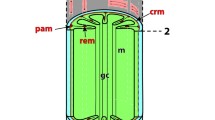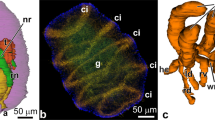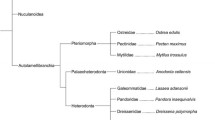Abstract
Using the Phalloidin-Rhodamine flourescence-labelling technique for F-actin, we have studied the development of the body wall musculature in Macrostomum hystricinum marinum and in thepolyclad Hoploplana inquilina. The structure of the muscle grid in the freshly hatched Macrostomum (see also Rieger & Salvenmoser, 1991) and the young larva of Holplana served as reference systems for the embryonic development of the body wall musculature. In Macrostomum muscle fiber differentiation starts around 60% of developmental time between egg-laying and hatching, and in Hoploplana around 80% of embryonic development.
In Macrostomum, early stages show TV-antenna-like arrangements of one longitudinal and several circular fibers. In Hoploplana our preliminary results show a particularly large, longitudinal fiber on either side of the body. These primary longitudinal fibers may serve as a ‘founder cell’ for other longitudinal fibers and as spatial guides for the circular muscles. Similar ‘founder cells’ have been reported during early muscle differentiation in leeches (Jellies & Kristan, 1988; Jellies, 1990). In Hoploplana, a special muscle system is present at the outset under the apical organ. It consists of what seems to be a spirally toranged fiber — when seen in head-on view — and of two additional fibers crossing this spiral, from the later developing posterior to the anterior lobe.
TEM-studies of embryos of Macrostomum suggest that the longitudinal nerve cords represent an important guide during early differentiation of the pattern within the body wall musculature. Young stages of myoblasts can be identified along the main lateral nerve cord. Commonly, the myoblasts are seen to alternate with young neurons in their position along the nerve cord. Embryonic stages of Macrostomum hystricinum marinum were obtained from our cultures (Rieger et al., 1988). Immediately prior to fixation (Paraformaldehyde, Stephanini's fixative) the eggshells were punctured with tungsten needles. We noted some variability of developmental time for certain embryonic stages, which we cannot explain. Developmental stages of Hoploplana inquilina were collected at the Marine Biological Laboratory, Woods Hole, MA, USA according to the procedure outlined in Boyer (1987) and Boyer (1989). They have been timed in relation to normal developmental time to an early Müller's larva at about 100 hours.
Similar content being viewed by others
References
Boyer, B. C., 1987. Development of in vitro fertilized embryos of the polycad flatworm Hoploplana inquilina following blastomere separation and deletion. Roux's Arch. dev. Biol. 196: 158–164.
Boyer, B. C., 1989. The role of the first quartet micromeres in the development of the polyclad Hoploplana inquilina, Biol. Bull. 177: 338–343.
Jellies, J. & W. B. Kristan, 1988. Embryonic assembly of a complex muscle is directed by a single identified cell in the medicinal leech. J. Neurosci. 8: 3317–3326.
Jellies, J., 1990. Muscle assembly in simple systems. TINS 13: 126–131.
Rieger, R. M., M. Gehlen, G. Haszprunar, M. Homlund & A. Legniti, 1988. Laboratory cultures of marine Macrostomida (Turbellaria). Progr. Zool. 36: 523.
Rieger, R. & W. Salvenmoser, 1991. Demonstration of the muscle system in whole mounts of Macrostomum hystricinum marinum (Turbellaria, Macrostomida). Am. Zool. 31: 35.
Author information
Authors and Affiliations
Rights and permissions
About this article
Cite this article
Rieger, R.M., Salvenmoser, W., Reiter, D. et al. Differentiation of the body wall musculature in Macrostomum and Hoploplana (Turbellaria, Platyhelminthes). Hydrobiologia 305, 225 (1995). https://doi.org/10.1007/BF00036392
Issue Date:
DOI: https://doi.org/10.1007/BF00036392




